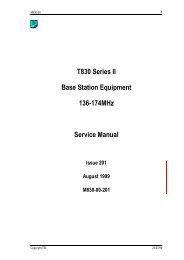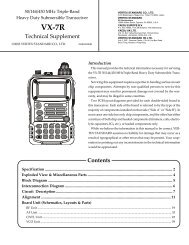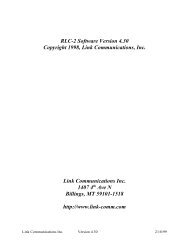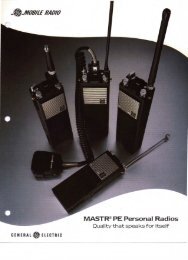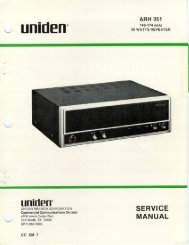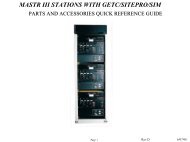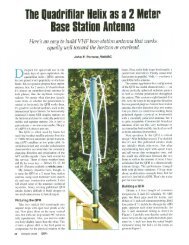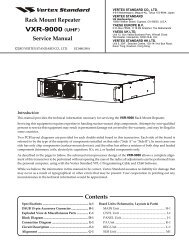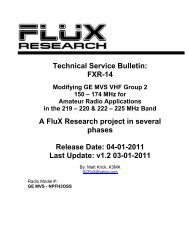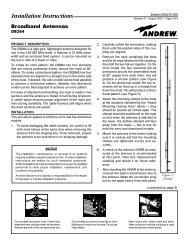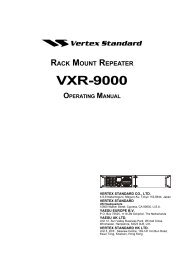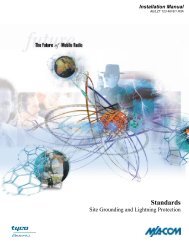TKR-750 service manual
TKR-750 service manual
TKR-750 service manual
You also want an ePaper? Increase the reach of your titles
YUMPU automatically turns print PDFs into web optimized ePapers that Google loves.
CIRCUIT DESCRIPTION<br />
<strong>TKR</strong>-<strong>750</strong><br />
1. Outline<br />
The <strong>TKR</strong>-<strong>750</strong> is a VHF/FM repeater designed to operate<br />
in the frequency range of 136 to 174MHz.<br />
The unit consists of receiver, transmitter, phase-locked<br />
loop (PLL) frequency synthesizer, and control circuits.<br />
2. Receiver Circuit<br />
The receiver is double conversion super-heterodyne, designed<br />
to operate in the frequency range of 146MHz to<br />
174MHz (K,E) or 136MHz to 150MHz (K2).<br />
The receiver circuit located in TX-RX unit (X57-626 A/2)<br />
consists of the following : 2-1 front-end circuit, 2-2 first<br />
mixer, 2-3 IF amplifier circuit, 2-4 audio amplifier circuit, and<br />
2-5 squelch circuit.<br />
2-1. Front-end Circuit<br />
The front-end circuit consists of BPF L2/L3, RF amplifier<br />
Q1, and BPF L5/L6/L7. The helical BPF covers frequency<br />
ranges 146 to 174MHz (K,E) and 136 to 150MHz (K2), with a<br />
passband of 3.0MHz.<br />
The BPF L5/L6/L7 attenuates the unwanted signals, and<br />
sends only the necessary signal to the first mixer DBM A1.<br />
2-2. First Mixer<br />
The signal from the BPF is heterodyned with the first local<br />
oscillator signal from the PLL frequency synthesizer circuit<br />
at the first mixer DBM (A1) to become a 44.85MHz first<br />
intermediate frequency (IF) signal. The first IF signal is fed<br />
through two monolithic crystal filters (XF2; Wide, XF1; Narrow)<br />
to further remove spurious signals.<br />
2-3. IF Amplifier<br />
The first IF signal is amplified by Q2 and Q3, and then<br />
enters IC9 (FM system IC). The signal is heterodyned again<br />
with a second local oscillator signal (44.395MHz) with in IC9<br />
to become a 455kHz second IF signal. The second IF signal<br />
is fed through a 455kHz ceramic filter, CF1 (Wide), CF2 (Narrow)<br />
to further eliminate unwanted signal, and the quadrature<br />
detection circuit FM-detects the signal to produce a<br />
base-band signal and output it from pin 11.<br />
TX-RX unit (X57 A/2): TX-RX<br />
RX ANT<br />
IF AMP<br />
Q3<br />
D2<br />
SW<br />
MCF (Wide)<br />
XF2<br />
MCF (Narrow)<br />
XF1<br />
D1<br />
SW<br />
IF AMP<br />
Q2<br />
44.85MHz<br />
1st MIX<br />
DBM A1<br />
BPF<br />
L5,L6,L7<br />
RF AMP<br />
Q1<br />
BPF<br />
L2,L3<br />
RSSI<br />
Q4<br />
SW<br />
W/N<br />
44.850MHz<br />
FM SYSTEM IC<br />
IC9<br />
QUD<br />
W/N<br />
LPF<br />
IF AMP<br />
Q9<br />
IF AMP<br />
Q8<br />
RX VCO<br />
A3 (X58-478)<br />
VCO A<br />
VCO B<br />
DET W/N<br />
NOISE DET<br />
D5<br />
SQL<br />
DET<br />
NOISE AMP<br />
Q7<br />
CF1 (Wide)<br />
SW<br />
SW<br />
D4<br />
D3<br />
CF2 (Narrow)<br />
455kHz<br />
W/N<br />
X1<br />
44.395MHz<br />
fRX+44.85MHz<br />
TX-RX unit (X57 B/2): Control<br />
DEI DEO<br />
AMP<br />
IC608<br />
AINR<br />
IC614<br />
AMP<br />
IC619 (B/2)<br />
CODEC<br />
AOUTR<br />
LPF<br />
IC619 (A/2) RXI RXO<br />
IC615<br />
DAC<br />
IC622<br />
SW<br />
Q606<br />
MUTE<br />
IC629<br />
AF<br />
AMP<br />
RD<br />
ASQ<br />
RSSI<br />
IC604<br />
CPU<br />
RA<br />
AM<br />
SPM<br />
IC621<br />
INV Q605<br />
Fig. 1<br />
Receiver circuit<br />
INT SP<br />
17



